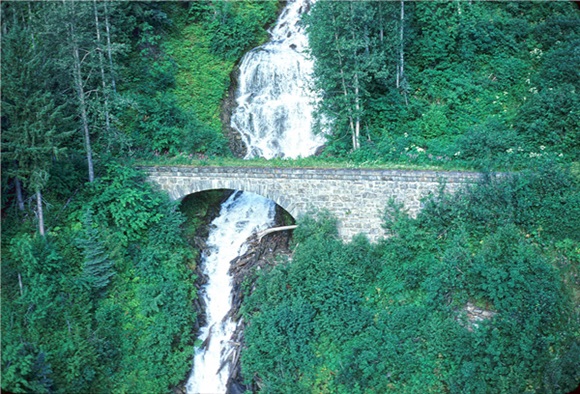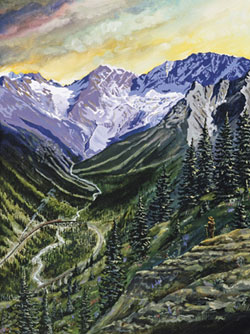
Why is Rogers Pass National Historic Site a special place?
Rogers Pass National Historic Site
Rogers Pass National Historic Site is a large cultural landscape at the heart of Glacier National Park - a situation that is unusual in the Canadian national park system. Parks Canada staff must actively manage natural processes in order to protect and stabilize in situ cultural resources (eg: removal of new vegetation growth to prevent disruption of stone ruins).

Cascade Creek stone arch railway bridge
© Parks Canada / John Woods

Railway trestles in the Loop Brook Valley
© Parks Canada / Zuzana Driediger
- Working for the Canadian Pacific Railway Company, Major Albert Bowman Rogers first discovered this gap through the impenetrable Selkirk Mountain barrier in 1881, and he returned to confirm the existence of the pass a year later.
- Construction of the railway line on the steep mountainsides and over the deep gorges of the Selkirk Mountains required engineering solutions that represented innovative breakthroughs during Victorian times.
- Operation of a railway line through the incredible avalanche danger and 12 metre (40 foot) annual snowfall of Rogers Pass demanded new technologies and new skills from the railroaders.
- People of many cultures contributed their labour to the search for the pass and construction and operation of the railway. Railway employees and contractors included Aboriginal people, new immigrants from many Asian and European countries, American contractors and people from the new country of Canada.
- Completion of the railway fulfilled Prime Minister John A. Macdonald's promise of a land connection to British Columbia, made when the colony joined the Canadian Confederation in 1871. It also realized Macdonald's vision of a trans-continental nation, ended British Columbia's isolation from the rest of Canada, and helped to prevent the absorption of the colony into the United States.
- At the urging of the Canadian Pacific Railway, the construction of the rail line led directly to the establishment of Glacier and Yoho national parks in 1886, the country's second and third national parks after Banff was established in 1885.
- Date modified :